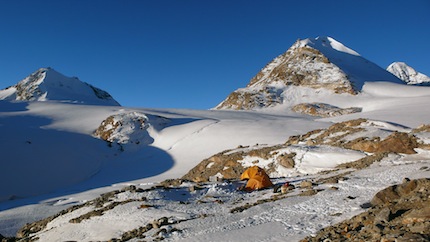The earth is warming up, glaciers are shrinking. However, not all meltwater is causing sea-level rise as feared. In Tibet, as measurements taken by an international team of researchers including the University of Zurich reveal, a significant proportion of meltwater remains on land. The consequences are, however, equally negative: it can cause lakes without an outlet to overflow and flood valuable pastureland.
Glaciers are important indicators of climate change. Global warming causes mountain glaciers to melt, which, apart from the shrinking of the Greenlandic and Antarctic ice sheets, is regarded as one of the main causes of the present global sea-level rise. Tibet’s glaciers are also losing mass clearly, as scientists from the universities of Zurich, Tubingen and Dresden reveal using satellite-based laser measurements. Over the last decade, the research team has detected a “clear loss in mass of around 16 gigatonnes a year in around 80% of the Tibetan glaciers,” said Tobias Bolch, a glaciologist from the University of Zurich involved in the study – that’s around 6% of the total loss in mass of all the glaciers on Earth.
Some glaciers in Tibet are growing
However, the measurements also bore some positive news: Some glaciers in the central and north-western part of the Tibetan Plateau have actually grown in mass. While the glaciers in the monsoon-influenced southern and eastern part of the plateau have melted significantly, the scientists recorded a neutral or even slightly positive result in the central and north-western area of the country. Nonetheless, as Bolch noted, “On average, the entire region is clearly characterised by a loss in mass.”
At a first glance, evidence that not all of the meltwater flows into the ocean via the large Asian currents and causes the sea level to rise seems positive. “However, flooding is still a problem,” said Bolch. After all, a large proportion of the melt – around two gigatonnes a year, as scientists have quantified for the first time – flows into lakes without an outlet on the plateau, causing them to burst their banks. “In many regions, this means that valuable pasture areas become submerged,” explained the glaciologist.
New techniques provide more precise results
Stretching over an area of around 40,000 square kilometres, the Tibetan Plateau’s glaciers account for over a third of High Asia’s ice cover and are about twenty times the size of the ice surface of the Alps. For their study, the international team of researchers evaluated satellite-based laser measurements of the glacier surfaces on the Tibetan Plateau between 2003 and 2009. “Thanks to these measurements, we were able to gauge the temporal changes of the glacier heights and – combined with a detailed glacier inventory – changes in mass of the glaciers in Tibet, which are extremely difficult to access,” said Tubingen scientists Niklas Neckel and Jan Kropacek, explaining the measuring technique.
The results published this week in Environmental Research Letters seem to contradict the data from a satellite mission based on other measuring methods, which indicates a slight increase in mass in the glacier ice for an almost identical period of time. For Bolch, the different measurement values depend on the amount of meltwater that remains on the plateau and does not flow away into the sea – and which his team has now managed to measure accurately for the first time. He attributes the data from the other studies that points to glacial growth more to other influences on the calculations – such as an increase in rainfall.
This was first published by the University of Zurich.
Niklas Neckel, Jan Kropacek, Tobias Bolch and Volker Hochschild. Glacier mass changes on the Tibetan Plateau 2003 – 2009 derived from ICESat laser altimetry measurements. Environmental Research Letters. January 16, 2014
